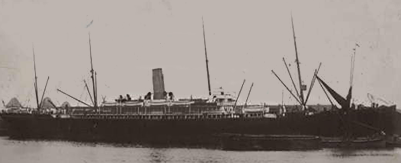SS Gothic
SS Gothic, yard number 267, was a 7,755 ton passenger and cargo ship, built for the White Star Line by Harland and Wolff, Belfast, Northern Ireland, UK. Launched on 28th June 1893, Gothic was intended to sail from Britain to Australia and New Zealand.

SS Gothic.
Upon completion, in November 1893, Gothic sailed from Belfast to Cardiff, Wales, UK for coal, and then sailed to Liverpool, England, UK, where the ship was opened up to the paying public for 1 shilling per person. The proceeds were donated to the Liverpool Seamen’s Orphans Asylum.
From Liverpool – to be ready for her maiden voyage – Gothic travelled to London. Gothic was reportedly the largest ship to have ever entered London’s port except for the by this time broken up SS Great Eastern.
While in London, Gothic was again opened up to the public at a cost of 1 shilling; this time the proceeds being donated to the Dreadnoughts Seamen's Hospital.
Gothic was part of a joint service between White Star Line and Shaw, Savill & Albion Line.
Under the command of Captain Jennings, on 28th December 1893, Gothic began her maiden voyage from London, UK to Wellington, New Zealand, via Plymouth, UK (arriving on 30th December), Cape Town, South Africa (arriving 18th January) and Hobart, Australia (arriving 4th February). Gothic arrived in Wellington on 9th February 1894. At the time she was the largest ship to have ever been to Australia and New Zealand.
The Mercury newspaper, printed in Hobart, described the voyage from Britain to Australia as being “a very pleasant one, and that the usual deck sports and entertainments were frequently held.” It was also noted that everyone was in good health.
After leaving Tenerife, on her way back home to London from Wellington, on 3rd June 1906, while under the command of Captain Bartlett, a smell of fire was discovered aboard Gothic. The next day it was discovered that the ships No.4 hold was on fire, and burning cargo, presumably wool, had to be thrown overboard. The hold was then filled with smoke – which was believed to have extinguished the fire.
On 6th June, near the south coast of Great Britain, the smell of smoke returned, and by the next morning the fire had considerably progressed. It was decided to evacuate the passengers at Plymouth, and with the fire out of control, Gothic was towed to Cattewater Harbour, Plymouth – where she was beached and flooded. The damage was considerable and took eight months to repair.
After being repaired, no longer needed on her current route, Gothic was transferred to the Red Star Line, like White Star, part of IMM, and was renamed Gothland. Gothland sailed from Europe to North America.
In 1911, Gothland was renamed back to her original name – Gothic – and served on the Britain to Australian route for the Aberdeen White Star Line – a company separate from but partly owned by the White Star Line. Gothic returned to Red Star Line and was again renamed Gothland in 1913, again sailing on the Europe to North America service.
While sailing from Montreal, Canada to Rotterdam, Netherlands on 23rd June 1914, Gothland struck/ran aground on a rock in the Isles of Scilly, Cornwall, UK. As the passengers were being taken off the ship in lifeboats, a lifeboat with 40 people inside fell and smashed; throwing the occupants into the sea. Fortunately, they were all rescued. Those onboard the ship were transferred to the SS Lyonesse, and Gothland was taken to Southampton, UK to be repaired.
On 18th May 1921, Gothland was used by the White Star Line for a single voyage from Naples to New York, arriving in New York on 1st June. She then returned to her usual Red Star service.
Gothland was broken up for scrap in Scotland, UK in 1926.